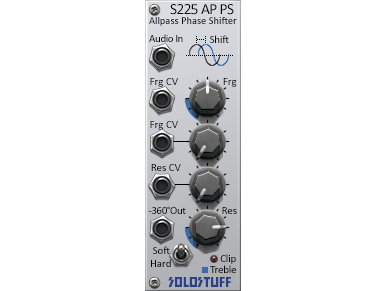Product Description
(This module is included in the System B)
Note: A phase shifter is different than a phaser. But some times a phaser is metaphorically called a phase shifter. If you want a phaser, check the S626.
A phase shifter is rather an advanced tool usually used by audio engineers to correct phase cancellations in the stereo field to achieve a more prominent and musical sound quality. It can also be used as creative tool to introduce subtle changes to the audio for enhancement. The S225 is more on the creative part because of the side effects and imperfections embedded. SoloStuff will probably introduce another phase shifter latter on to handle precise (angular) phase shifts.
A phase shifter works by adding a fixed or variable amount (angle) to the phases of the harmonics throughout the spectrum. At first glance, The output signal will sound almost exactly the same as the input, the interesting results happen when the output is further processed. For example, mixing the output of a phase shifter with the original input will yield a notch filter!!. This approach is usually used to create phaser effects.
The S225 works by subtracting a phase shift of 360° that is variably applied starting from 0Hz up-to half of the DAWs sampling rate where it completes a full 360° phase shift. The Frq knob/CV is the frequency where the shift is concentrated. The higher the resonance (Res) the more of the phase shift happens at and around the Frq frequency. Decreasing Res will spread the phase shift more and more across the spectrum. Notice that Frq has two patch points, one without and one with an attenuator. The one without an attenuator is meant to be used for key tracking. So it makes sense to connect it to note voltage*. The other patch point is meant for modulation.
The module has two modes of operation flipped by a switch. Soft and Hard. The deference between them is mainly apparent when using audio/fast rate modulation of the Frq (cut off) and/or Res. Soft is derived from an analog topology which can handle audio rate modulation without overloading or clipping. Yet you may find that Hard mode may sound more interesting some times at audio rate modulation because it can heavily overdrive and distort the signal specially if the audio rate modulation is not too high.
Usage Ideas
1. Stereo Generator: If you have a mono signal that you wish to turn to stereo but without using a dramatic effect like a reverb or chorus. The S225 can be used to introduce subtle changes. Turn the Frq to the minimum or some where in the indicated blue region. Then play with the Res as desired until an acceptable sound is reached. Use that sound as a second channel (left or right) to produce a stereo signal along with the original mono.
2. Distortion Unit: Place the S225 after a VCA. Set the switch to Hard mode. Set Res to anywhere bellow 12 o’clock. Modulate the resonance with the same signal that your feeding to the audio, set the Res CV attenuator to 12 o’clock. Now increase the VCA amplification until the S225 clips and remain clipping all the time (While there is audio in). Change the Frq and Res CV as desirable. Note here that the S225 by default clips at +6db FS, not at the usual +12db FS.
3. Treble Boost: This was an unexpected side effect that we found during the design. Set the switch to Hard mode. Place both the Frq and Res at the blue indicated areas. The high frequency of any audio will be boosted making the sound sharper and more crisp. Unfortunately this side effect only works at NO oversampling. Because when oversampling is used the treble band becomes ultra sonic and therefore inaudible**.
4. Custom phaser building block: Although this involves more advanced patching and is not easy to tweak. The idea is to place multiple S225 modules in series (one feeding the next) and then mixing the output with the original input to create multiple notches. Modulating the notches then would produce a phaser effect. Feeding back some of the output to input will create peaks!!.
* Like a 0.1V/oct output
** Ultrasonic is filtered anyway, unless you use a DAW sampling rate higher than 48Khz. Either ways, we can’t hear it.


Reviews
There are no reviews yet.